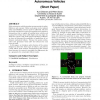Free Online Productivity Tools
i2Speak
i2Symbol
i2OCR
iTex2Img
iWeb2Print
iWeb2Shot
i2Type
iPdf2Split
iPdf2Merge
i2Bopomofo
i2Arabic
i2Style
i2Image
i2PDF
iLatex2Rtf
Sci2ools
ATAL
2008
Springer
2008
Springer
Mitigating catastrophic failure at intersections of autonomous vehicles
Fully autonomous vehicles promise enormous gains in safety, efficiency, and economy. Before such gains can be realized, safety and reliability concerns must be addressed. We have previously introduced a system for managing such vehicles at intersections that is capable of handling more vehicles and causing fewer delays than traffic lights and stop signs [2]. While the system is safe under normal operating conditions, we have not discussed the possibility or implications of unforeseen mechanical failures. Because the system orchestrates such precarious "close calls" the tolerance for such errors is small. In this paper, we introduce safety features of the system designed to deal with these types of failures, and perform a basic failure mode analysis, demonstrating that without these features, the system is unsuitable for deployment due to a propensity for catastrophic failure modes. Categories and Subject Descriptors I.2 [Artificial Intelligence]: Miscellaneous Keywords multi...
ATAL 2008 | Autonomous Vehicles | Failure Modes | Intelligent Agents | Unforeseen Mechanical Failures |
| Added | 12 Oct 2010 |
| Updated | 12 Oct 2010 |
| Type | Conference |
| Year | 2008 |
| Where | ATAL |
| Authors | Kurt M. Dresner, Peter Stone |
Comments (0)

